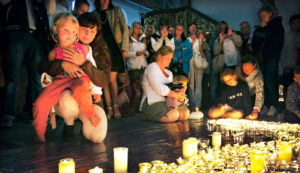Anders Breivik is a monster who deserves a slow and painful death. But Norwegian criminal justice is far too humane to grant this most inhumane of killers that kind of punitive treatment: Breivik, who murdered 77 people in a far-Right terrorist atrocity in 2011, resides in a three-room suite that includes a treadmill, a refrigerator, a television with a DVD player, a Sony PlayStation, and a desk with a type-writer.
Last week, Breivik appeared before a parole hearing, asking to be released from prison. If you’re unfamiliar with the procedural mechanics of Norway’s criminal justice system, you might think that “Breivik” and “parole” have no business belonging to the same sentence. But in Norway offenders are legally entitled to apply for parole at the halfway point of a maximum prison term.
Breivik, who in 2016 ludicrously filed a complaint that he was being subject to degrading and inhumane treatment in prison and who has now served 10 years of his 21-year sentence, was never going to renounce the opportunity to further ridicule the largesse of his liberal jailors: when he walked in to the courtroom, ponced-up in a black slim-fit suit that was plastered all over him like cheap spray tan, he flashed a Nazi salute. He then gave an hour-long speech, in which he said: “Today, I strongly dissociate myself from violence and terror… I hereby give you my word of honour that this is behind me forever,” straining credulity not least by his invocation of the word “honour”. For some reason, the court allowed this travesty to be filmed and broadcast. It did not, however, allow the travesty of freeing him: Breivik’s parole was denied.
As a criminologist, I am not supposed to say that Breivik is a monster, much less express any vengeful emotions toward him. Rather, I am supposed to place him within a broader context and resist the seductive temptation to “Other” him.
I am supposed to say that he’s a product of society, whose homicidal actions speak to the deep alienation that some young men experience in a spiritually depleted world at the End of History. Or I am supposed to highlight how Breivik had internalised the trauma of a painful childhood — his mother tried to orphan him and his sister when he was a child — and then sought to cancel out that trauma by violently imposing it on the people who inhabited that same desolate society. I am supposed to take all the monstrousness that Breivik unleashed against his multiple victims, most of them teenagers, and causally tie it not to Breivik the person but to other sources of social dysfunction that produced him. I am supposed to say that Breivik is, to annex the title of Åsne Seierstad’s account of his massacre, One of Us.
As a criminologist who studies terrorism, I’m all too familiar with Hannah Arendt’s thesis that while human cruelty can be monstrous, its perpetrators are often pathetic men (and sometimes women) who are neither demonic nor sadistic, but ordinary people with grubby little motives, like career advancement, pleasing superiors or not wanting to stick one’s neck out for fear of censure.
When I first read Christopher Browning’s Ordinary Men, a book about how ordinary Germans, from all walks of life, willingly participated in the open-air slaughter of tens of thousands of Jewish civilians in occupied Poland between 1941 and 1942, I was impressed by its overall Arendtian argument; it seemed profound and radical. According to Browning, the men of Reserve Police Battalion 101 killed not because they were fanatics motivated by the ideology of murderous anti-Semitism, but because they were psychologically weak.
As Browning puts it: “To break ranks and step out, to adopt overtly nonconformist behaviour, was simply beyond most of the men. It was easier for them to shoot…” A broader argument soon materialises: that there is a line of good and evil that runs through every human being; that we are all, when the circumstances permit it, capable of terrible acts of inhumanity.
I have now come to think of this account of human evil as banal and partial. And I have come to dislike the glibness with which the account is expressed by its defenders, as though they are imparting some deep and unsettling truth about the human condition that is lost on the plebs with all their talk of evil and mythical monsters.
Well, we are not all capable of inhumanity, and while some people fearfully succumb to the weight of group dynamics and kill, others can’t wait to get started with the business of slaughter and need only the flimsiest of pretexts to enter a berserk state. And still others not only refuse to follow orders, but bravely intervene to stop their fellows from killing civilians.
The problem with the Arendtian thesis about ordinary killers, and the broader consensus that has hardened around it, is that it can’t explain ideologically fervent men who revel in the idea of murdering and humiliating scores of their perceived enemies. Men like Breivik.
Granted, Breivik was a pudgy-faced, piggy-eyed loser with blond sweaty hair — all now shaven off. As Seierstad recounts in her book, Breivik’s life was an elaborate catalogue of miserable failures. The problem was his tremendous narcissism and resentful anger, which sabotaged him at every turn.
As a teenager, he reinvented himself as a graffiti artist called “Morg”, claiming to be the top “tagger” in Oslo. But he was shit and annoying and was soon excluded from the “tagger” community. In another reinvention, he tried his hand at selling fake university diplomas on the internet, until he nearly got caught. He then joined the anti-immigration Progress party, intent on becoming a politician. That, too, went nowhere. Women, in particular, seemed to find him radioactive: he ordered a Belarusian mail-order bride who left as swiftly as she came. He would brag to his friends that he was a brothel man; this self-righteous and disgust-prone creep was probably terrified of women.
But for all these squalid and all-too human details, Breivik was a singular individual with a troglodytic interior world that made him stand out. Around 2006, he moved back in with his mother and retreated from the world, living almost entirely in his imagination. He became obsessed with the idea that white European culture was under existential threat from marauding hordes of Muslim migrants, abetted by white cultural Marxists and multiculturalists. And he began nurturing the fantasy that he would lead a secret order of knights to stop this cultural “genocide”.
Yes, Breivik was a chump and a radical loser, but he was no ordinary killer following orders, still less some colourless bureaucrat orchestrating mass-murder from behind the scenes, as was the case with Adolf Eichmann, the apotheosis of Arendt’s banal evil. Far from being banal, Breivik’s motives were related to his sense of worthlessness and lack of virility. Only by violently crushing all those who had made him feel weak and pathetic could he restore his sense of manly “honour”. In short, Breivik was an enthusiastic killer who wanted to kill.
One of the dark ironies exhibited in Breivik’s parole hearing was his appropriation of liberal explanatory motifs to excuse his monstrous behaviour. “I was brainwashed,” Breivik told the court on the first day of the proceedings. He had been radicalised online, he elaborated, embracing the language of victimhood that he so despises in others and that so many progressives employ to rationalise or explain away the crimes of “the oppressed”.
Breivik once had a grudging admiration for al Qaeda, and the courage with which its foot-soldiers embraced death in defence of their beliefs. There was no culture of violent martyrdom among neo-Nazis, and he bitterly lamented that. Now, it seems, Breivik has taken a leaf out of the jihadi apologia playbook, claiming that he was radicalised by dangerous material on the internet. While he hasn’t gone the full Shamima Begum, who has explicitly renounced Isis and its ideology, his displacement of responsibility onto the internet closely resembles hers and many others like her.
It is hard to know if Breivik’s claim that he was radicalised online is sincere. Given that he continues to hold firm to his to neo-Nazi beliefs, it seems doubtful. In fact, I am inclined to believe that it was some private joke aimed at other neo-Nazis to mock liberals who use the self-same explanatory trope to excuse the radicalisation of jihadists.
I also don’t blame Breivik for flagrantly ridiculing his liberal oppressors, as he sees them. In Breivik’s eyes, they are his enemies, and he is a political prisoner. Perhaps the Norwegian authorities should in turn take him seriously and recognise him as such, which would mean refusing him any public stage on which to propagandise his vile beliefs.
Even in liberal Norway tolerance should have it limits — as should the virtue that professes that even the most fanatical and dangerous of murderers should be given a chance to present a case for their release.
Disclaimer
Some of the posts we share are controversial and we do not necessarily agree with them in the whole extend. Sometimes we agree with the content or part of it but we do not agree with the narration or language. Nevertheless we find them somehow interesting, valuable and/or informative or we share them, because we strongly believe in freedom of speech, free press and journalism. We strongly encourage you to have a critical approach to all the content, do your own research and analysis to build your own opinion.
We would be glad to have your feedback.
Source: UnHerd Read the original article here: https://unherd.com





